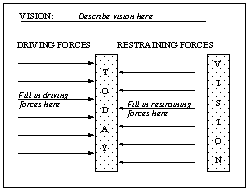Force field Analysis
Force field analysis (Lewin 1951) is widely used in change
management and can be used to help understand most change processes
in organisations.

In force field analysis change, is characterised as a state
of imbalance between driving forces (e.g. new personnel, changing
markets, new technology) and restraining forces (e.g. individuals'
fear of failure, organisational inertia). To achieve change towards
a goal or vision three steps are required:
- First, an organisation has to unfreeze the driving and restraining
forces that hold it in a state of quasi-equilibrium.
- Second, an imbalance is introduced to the forces to enable
the change to take place. This can be achieved by increasing
the drivers, reducing the restraints or both .
- Third, once the change is complete the forces are brought
back into quasi-equilibrium and re-frozen.
Thomas (1985) explained that although force field analysis
has been used in various contexts it was rarely applied to strategy.
He also suggested that force field analysis could provide new
insights into the evaluation and implementation of corporate
strategies. More specifically Maslen and Platts (1994) applied
force field analysis to manufacturing strategy. Force field analysis
is potentially a powerful technique to help an organisation realise
a manufacturing vision.
References
- Lewin K. (1951) 'Field Theory in Social Science', Harper
and Row, New York.
- Maslen R., Platts K.W. (1994) 'Force Field Analysis: A Technique
to Help SMEs Realise their Intended Manufacturing Strategy',
in Operations Strategy and Performance, 1st European Operations
Management Association Conference, University of Cambridge, June,
pp.587-588.
- Thomas J. (1985) 'Force Field Analysis: A New Way to Evaluate
Your Strategy', Long Range Planning, Vol. 18, No. 6, pp. 54-59.
|